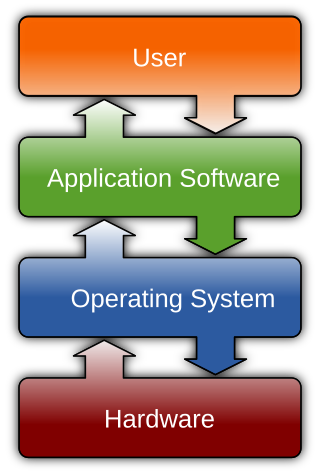Related Research Articles

Software is a set of computer programs and associated documentation and data. This is in contrast to hardware, from which the system is built and which actually performs the work.

LaTeX is a software system for typesetting documents. LaTeX markup describes the content and layout of the document, as opposed to the formatted text found in WYSIWYG word processors like Microsoft Word, LibreOffice Writer and Apple Pages. The writer uses markup tagging conventions to define the general structure of a document, to stylise text throughout a document, and to add citations and cross-references. A TeX distribution such as TeX Live or MiKTeX is used to produce an output file suitable for printing or digital distribution.

A wiki is a form of online hypertext publication, collaboratively edited and managed by its own audience, using a web browser. A typical wiki contains multiple pages for the subjects or scope of the project, and could be either open to the public or limited to use within an organization for maintaining its internal knowledge base.

A website is a collection of web pages and related content that is identified by a common domain name and published on at least one web server. Websites are typically dedicated to a particular topic or purpose, such as news, education, commerce, entertainment or social networking. Hyperlinking between web pages guides the navigation of the site, which often starts with a home page. As of May 2023, the top 5 most visited websites are Google Search, YouTube, Facebook, Twitter, and Instagram.
In computing, cross-platform software is computer software that is designed to work in several computing platforms. Some cross-platform software requires a separate build for each platform, but some can be directly run on any platform without special preparation, being written in an interpreted language or compiled to portable bytecode for which the interpreters or run-time packages are common or standard components of all supported platforms.
A HTML editor is a program used for editing HTML, the markup of a web page. Although the HTML markup in a web page can be controlled with any text editor, specialized HTML editors can offer convenience, added functionality, and organisation. For example, many HTML editors handle not only HTML, but also related technologies such as CSS, XML and JavaScript or ECMAScript. In some cases they also manage communication with remote web servers via FTP and WebDAV, and version control systems such as Subversion or Git. Many word processing, graphic design and page layout programs that are not dedicated to web design, such as Microsoft Word or Quark XPress, also have the ability to function as HTML editors.

In relation to the Japanese language and computers many adaptation issues arise, some unique to Japanese and others common to languages which have a very large number of characters. The number of characters needed in order to write in English is quite small, and thus it is possible to use only one byte (28=256 possible values) to encode each English character. However, the number of characters in Japanese is many more than 256 and thus cannot be encoded using a single byte - Japanese is thus encoded using two or more bytes, in a so-called "double byte" or "multi-byte" encoding. Problems that arise relate to transliteration and romanization, character encoding, and input of Japanese text.

Computer accessibility refers to the accessibility of a computer system to all people, regardless of disability type or severity of impairment. The term accessibility is most often used in reference to specialized hardware or software, or a combination of both, designed to enable the use of a computer by a person with a disability or impairment.

A screen reader is a form of assistive technology (AT) that renders text and image content as speech or braille output. Screen readers are essential to people who are blind, and are useful to people who are visually impaired, illiterate, or have a learning disability. Screen readers are software applications that attempt to convey what people with normal eyesight see on a display to their users via non-visual means, like text-to-speech, sound icons, or a braille device. They do this by applying a wide variety of techniques that include, for example, interacting with dedicated accessibility APIs, using various operating system features, and employing hooking techniques.
Web development is the work involved in developing a website for the Internet or an intranet. Web development can range from developing a simple single static page of plain text to complex web applications, electronic businesses, and social network services. A more comprehensive list of tasks to which Web development commonly refers, may include Web engineering, Web design, Web content development, client liaison, client-side/server-side scripting, Web server and network security configuration, and e-commerce development.

The Perkins Brailler is a "braille typewriter" with a key corresponding to each of the six dots of the braille code, a space key, a backspace key, and a line space key. Like a manual typewriter, it has two side knobs to advance paper through the machine and a carriage return lever above the keys. The rollers that hold and advance the paper have grooves designed to avoid crushing the raised dots the brailler creates.
Hancom Office is a proprietary office suite that includes a word processor, spreadsheet software, presentation software, and a PDF editor as well as their online versions accessible via an internet browser.

Web 2.0 refers to websites that emphasize user-generated content, ease of use, participatory culture and interoperability for end users.
Mozilla Firefox has features that allow it to be distinguished from other web browsers, such as Chrome and Internet Explorer.
Pagination, also known as paging, is the process of dividing a document into discrete pages, either electronic pages or printed pages.
In programming and software design, an event is an action or occurrence recognized by software, often originating asynchronously from the external environment, that may be handled by the software. Computer events can be generated or triggered by the system, by the user, or in other ways. Typically, events are handled synchronously with the program flow; that is, the software may have one or more dedicated places where events are handled, frequently an event loop.
Screenwriting software are word processors specialized to the task of writing screenplays.
Sinhala language software for computers have been present since the late 1980s but no standard character representation system was put in place which resulted in proprietary character representation systems and fonts. In the wake of this CINTEC introduced Sinhala within the UNICODE standard. ICTA concluded the work started by CINTEC for approving and standardizing Sinhala Unicode in Sri Lanka.
Bengali input methods refer to different systems developed to type the characters of the Bengali script for Bengali language and others, using a typewriter or a computer keyboard.

Ginger Software is an American and Israeli start-up specialized in Natural Language Processing and AI. The main products are tools aiming to improve written communications, develop English speaking skills and boost productivity. The company was founded in 2008 by Yael Karov and Avner Zangvil. Ginger Software uses the context of complete sentences to suggest corrections. In December 2011, Ginger Software was one of nine projects approved by the Board of Governors of the Israel-U.S. Binational Industrial Research and Development Foundation for a funding of $8.1 million. The company also raised $3 million from private Israeli and US investors in 2009.